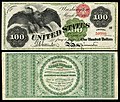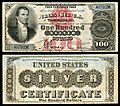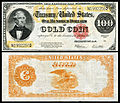| Country | United States |
|---|---|
| Value | $100 |
| Width | 157 mm |
| Height | 66.3 mm |
| Weight | ≈ 1.0 [1] g |
| Security features | Security fibers, watermark, 3D security ribbon, security thread, color shifting ink, microprinting, raised printing, EURion constellation |
| Material used | 75% cotton 25% linen |
| Years of printing | 1861–present |
| Obverse | |
 | |
| Design | Benjamin Franklin's portrait by Joseph Duplessis, Declaration of Independence, quill pen, Syng inkwell with an imbedded image of the Liberty Bell |
| Design date | 2009 |
| Reverse | |
 | |
| Design | Independence Hall |
| Design date | 2009 |
The United States one-hundred-dollar bill (US$100) is a denomination of United States currency. The first United States Note with this value was issued in 1862 and the Federal Reserve Note version was first produced in 1914. [2] Inventor and U.S. Founding Father Benjamin Franklin has been featured on the obverse of the bill since 1914, [3] which now also contains stylized images of the Declaration of Independence, a quill pen, the Syng inkwell, and the Liberty Bell. The reverse depicts Independence Hall in Philadelphia, which it has featured since 1928. [3]
Contents
- History
- Large-size notes
- Small size notes
- Series dates
- Withdrawal of large denomination bills ($500 and up)
- References
- Further reading
- External links
The $100 bill is the largest denomination that has been printed and circulated since July 13, 1969, when the larger denominations of $500, $1,000, $5,000, and $10,000 were retired. [4] As of December 2018, [update] the average life of a $100 bill in circulation is 22.9 years before it is replaced due to wear.
The bills are also commonly referred to as "Bens", "Benjamins", or "Franklins", in reference to the use of Benjamin Franklin's portrait by the French painter Joseph Duplessis on the denomination, as "C-Notes" or "Century Notes", based on the Roman numeral for 100, or as "blue faces", based on the blue tint of Franklin's face in the current design. The bill is one of two denominations printed today that does not feature a president of the United States, the other being the $10 bill, featuring Alexander Hamilton. The Series 2009$100 bill redesign was unveiled on April 21, 2010, and was issued to the public on October 8, 2013. The new bill costs 12.6 cents to produce and has a blue ribbon woven into the center of the currency with "100" and Liberty Bells, alternating, that appear when the bill is tilted.
As of June 30, 2012, the $100 bill comprised 77% of all US currency in circulation. [5] Federal Reserve data from 2017 showed that the number of $100 bills exceeded the number of $1 bills. However, a 2018 research paper by the Federal Reserve Bank of Chicago estimated that 80 percent of $100 bills were in other countries. Possible reasons included $100 bills being used as a reserve currency against economic instability that affected other currencies, and use for criminal activities. [6]









